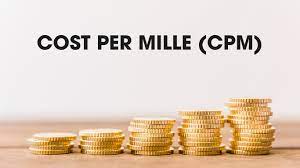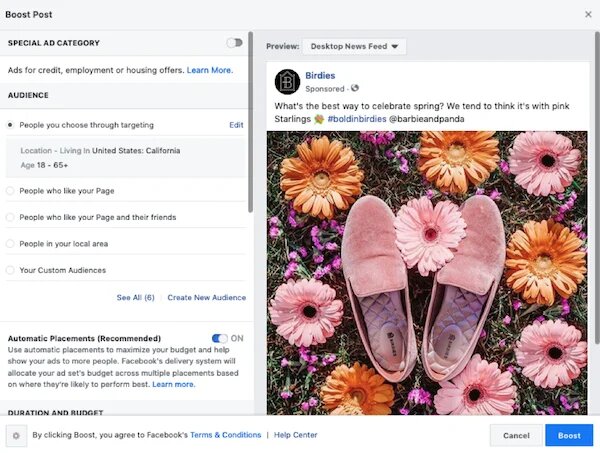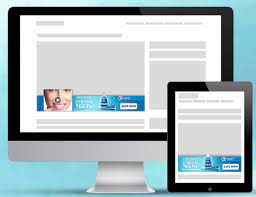The Ultimate Guide To Monetizing Your Blog.
If you’re a blog owner, it’s likely that you’ll be looking to make some money from your website at one time or another. Monetizing your blog can be a big decision to make and, if done poorly, can cause you to lose readers and cheapen your blog.
Having ran a few different blogs in the past, I’ve had a fair amount of experience in generating revenue from blogs. I’ve also spoken to some successful bloggers to find out what advice they would give to blog owners that are taking the plunge into monetization.
The Different Ways to Make Money From Your Blog
There are loads of different ways that you can bring in revenue from your blog – I’ve put together a list of them along with the advantages and disadvantages of choosing each method.
1. Cost Per Click (CPC) Advertising

Concept: Cost per click advertising (CPC) are ads that can be displayed on your website that you will be paid for every time someone clicks them. These are often served through an ad network like Google AdSense, Chitika, Bidvertiser, Clicksor and Yahoo! Advertising.
Advantages: If your blog brings in high traffic levels then displaying PPC adverts can be a quick and easy way to make steady revenue. If your blog is good at keeping your users on the pages then PPC ads can work well for driving high conversions, especially with in-post ads.
The big advantage of using a PPC network is that it takes just minutes to set up and you don’t really need any coding knowledge to implement it within your blog.
On top of this, PPC ads can easily be displayed within your blog posts to give extra impressions and revenue potentials – a quick way to do this is to create a WordPressshortcode to display your ad code (which saves you a lot of time otherwise spent copying & pasting).
Disadvantages: Unless you’re bringing in large volumes to your blog (over 50,000 visits a month), PPC ads aren’t going to give you the kind of revenue figures that you could get from other monetization sources. Yes, PPC ads are quick and easy to set up, but if you’re not making any money from them then what’s the point?
Another thing to consider is that the ads aren’t always the most aesthetically pleasing, and you don’t get to choose the exact ads that will be displayed – this can compromise your design, cheapen the site’s look and even have adverse effects on page load times (because you’re loading them from an external server instead of your own).
2.Cost Per Mile (CPM) Advertising

Concept: Cost per mile advertising (CPM) are ads that can be displayed on your website that you will be paid for every thousand impressions shown to your visitors. These are often served through an ad network like Casale Media, Value Click Media, Advertising.com, Tribal Fusion, and Right Media.
Advantages: Similarly to CPC advertising, cost per mile (CPM) ads can bring in good steady income from your blog if you’re piling through large levels of traffic. They are very easy to set up and you really don’t need any knowledge of coding to do so – all you have to do is create an advertising account and add the code to your site; simple.
On top of this, you don’t need to worry about how many click-throughs your ads will get because you’re paid per thousand impression. This way, as long as traffic remains steady, so will your ad revenue.
Disadvantages: Typically, CPM brings in ridiculously low returns – some ads pay out around $0.10 per thousand impressions! If you have into the millions of pageviews each month then you can be looking at a good return, but if you’re only bringing in thousands then I’d recommend looking at other options.
3. In-Content Text Affiliate Ads

Concept: The idea here is that you can link to products/services that you’re talking about via an affiliate text-link within your content. These links are usually contextual and relevant to the topic being discussed. For example, my review of iWriter has an affiliate text-link within the tutorial.
Advantages: These types of affiliate links can bring in some really good returns, especially if you accompany them with a review or tutorial on how to use the product/service or a specific feature of them. Matthew Woodward’s SEO blog is a prime example of effective in-content affiliate links.
Just looking at his August 2013 income report shows that he banked a modest $6,774.57 from only ~23,000 unique visitors – not bad at all!
Disadvantages: One disadvantage to using in-content affiliate links is that it can sometimes cheapen your content. This is particularly relevant within niches like travel, where readers can be really put off by articles that are too sales-orientated.
This is where you have to make a call on monetization vs user experience. In situations like this, the best policy is often to be as transparent as possible and make sure that your readers clearly understand that there are affiliate links in the post, and that they also understand why they are there (within a disclaimer, maybe).
4. In-Content Affiliate Banners

Concept: This monetization method involves adding in affiliate banners or widgets within your content (in a contextual manner). This is very similar to the text affiliate ads but with this method, the affiliate links are a lot more visible and often include an offer within them. An example would be within my review of Sprout Social’s social media management software.
Advantages: If you can make sure that the banners are relevant then you can make some good income this way. An advantage to using an affiliate banner over a text link is that it is a little more transparent that you are promoting something, as opposed to the text links that can sometimes be seen as you ‘deceiving’ readers.
Another advantage of using affiliate banners are that you have control over what banners you publish – within the fashion niche, these banners are used to great effect and can actually add to the design of your website.
Disadvantages: Like I mentioned before, having affiliate banners makes it clear that you are trying to make money from your content. This can put readers off, especially if it’s not in context. This can also cause a few issues when getting people to share/link to your articles and can sometimes reduce readability.
5. Getting a Blog Sponsor

Concept: Companies will often look to sponsor influential blogs within their niche. This usually includes having the brand mentioned within the header/sidebar of your website or even having cross-branding across the whole blog.
Advantages: If you have a relatively old domain or a lot of good quality links pointing to your website, a lot of companies would be interested in sponsoring your site with the proviso of getting a few backlinks from you.
This is a fairly common link building strategy that’s used by companies to boost their search engine rankings, so if you’re within a small niche, this can bring in some really good revenue.
Disadvantages: If one of the major USPs of your blog is your impartiality, then getting a corporate sponsor for your blog could jeopardise this. If you start turning your readers off then it’s a downward slope from there.
Another disadvantage of this is that you really need to be fairly established within your niche for companies to want to make the decision of sponsoring you.
5. Sponsored Posts

Concept: A sponsored post is essentially where a company or individual will pay to sponsor one of your articles. This will often be related to their company or product/services and will include a reference link to them within a disclaimer in the post.
For example, a furniture company might sponsor an article about the latest design trends of the year, and the post might feature some of their products.
Advantages: There’s a lot of money to be made from sponsored posts. Within certain niches, companies will be willing to pay a lot of money to have their products/services/brand featured on your site.
This is particularly relevant if you have a really good community on your blog that will engage with your site and drive through a lot of referral traffic to other websites.
Another advantage is how easy it can be to attain some of these opportunities. One method that I’ve used within my own travel blog in the past is to target internet marketing agencies with a specialism in the travel niche – you’d be surprised how easy it is to find them with a simple search.
If you want a more advanced technique then check out my link prospecting process.
Disadvantages: There are a few down-sides to this type of content. If you’re going to be monetizing your individual blog posts as ‘sponsored’ articles then you might find that your readers will be turned off. It can really cheapen the article, especially if you’re not disclosing clearly.
Secondly, a lot of companies will ask you to make the link a ‘dofollow’ instead of a ‘nofollow’ link, which breaks Google’s Webmaster Guidelines. On top of this, you will often find that the company/individual isn’t keen on you disclosing that the article is a sponsored post, which can leave you in a tricky situation.
6. YouTube Channel Sponsorship

Concept: If you’ve been creating a lot of video content on your blog and as a result you’ve built a good YouTube following, you might want to look at some ways of monetizing it.
Aside from the standard YouTube in-video ads (which give a very low return and are pretty damaging for user experience), you can get someone to sponsor your YouTube channel. This could be via a banner that shows on your channel page, a link within a video description, or a sponsored mention with the video itself.
Advantages: Getting a YouTube channel sponsor can work out to be very profitable, even if you want to use it as an alternative to in-video AdSense ads.
Another advantage of this is that you have full control over what is being displayed on your channel, unlike with the CPC ads that are out of your control – you might even be able to add more value to your subscribers with your sponsor.
An example of this could be through having a banner to your sponsor’s website that gives a discount on their products/services.
Disadvantages: This method isn’t the easiest to pull off and you will often need to have a really engaging audience as well as a large following to get a good return on investment.
Also, if your YouTube videos focus around your impartiality then having a corporate sponsor can dilute this image and jeopardise your image.
7. In-Text Advertising

Concept: This form of advertising used to be very popular a few years ago and is usually managed through an advertising platform. It works in a similar way to banner advertising except the text within your content will be linked to 3rd party websites – this is usually determined by the link anchor text.
For example, if you mention the phrase ‘sports equipment’, then the in-text advertising platform will associate this with a sports equipment website and a link will be made. Some popular in-text advertising platforms are MediaWhizz SEO, Text Link Brokers and Linkworth.
On top of going through a third party platform, you can sell text links independently.
This could be by reaching out to related companies within your niche to see if they would be interested, and can be in the form of in-article text links, footer links or sidebar links.
Advantages: If you’re using a third party advertising platform then it literally takes a few minutes to set all of it up. Once you’re set up you’ve got a completely automated monetization system running on your website which has virtually no maintenance requirements.
Also, if you’re publishing large volumes of content, you can end up making a good return from this method, plus you will be able to easily implement other monetization strategies to run alongside it.
Disadvantages: Doing things like this can often get you in a lot of hot water with Google. Most of the in-text advertising platforms (as mentioned above) actually place dofollow links from your website, therefore manipulating search rankings – you can see why Google might get a little annoyed.
Alongside this, you can damage user experience a lot. If your articles are full of irrelevant commercial links that are taking your users away from your website then it’s not only going to cheapen your content, but will also reduce the amount of pageviews that you’re capturing.
8. Sell Banner Advertising Space

Concept: This is a pretty straight forward concept and it involves offering space on your website for others to place banners. You can sell space independently by contacting potential advertising partners or advertising it within a page on your website, or you can through a third party broker, such as Buy Sell Ads.
Advantages: Selling advertising space is a very easy way to make some good money, both if your blog is bringing in large volumes of traffic or smaller volumes. If your blog is within a small niche and doesn’t necessarily have a huge amount of monthly web traffic, you can offer fixed costs for a month’s worth of advertising.
Advertising partners that are looking to target a very specific audience will often pay well for it, even if the total reach isn’t particularly large – it’s often more about relevance to them.
Alternatively, if your blog brings in a lot of web traffic, you can sell ad space based on cost per impression. You’ll often make a lot more cash out of this method of advertising when compared to the likes of AdSense, plus you can also get the chance to build a relationship with your ad partners and negotiate long-term commitments.
Disadvantages: Although setting this up within the likes of Buy Sell Ads is relatively quick, you’re not guaranteed that anyone will actually buy advertising space from you. So, whilst the profit margins may be higher, you may need to do a little more promotional work to actually secure a buyer, which some blog owners don’t like doing.
9. In-Image Advertising

Concept: A slightly less well-known method of monetization that is only offered through a few advertising networks. It involves adding a text ad overlay to the images on your website when a user hovers over them.
For example, if you’ve recently written an article about the best hotels to stay at in Amsterdam, you could monetize the images within the post by allowing advertisers to have their ad displayed when a user hovers over them – this would be relevant to the image, of course.
One advertising network that offers this is Reachli, and they have a great video on their site explaining this in more detail.
Advantages: This is another method that takes very little time to set up and can be easily run in conjunction with other monetization techniques. Also, like with in-text advertising, if you’re publishing a lot of fresh content on your blog on a regular basis (i.e. multiple times a day) then you can see a good return from it.
Disadvantages: One major disadvantage when using in-image advertising is that you don’t have a say on the partners that will be advertising on your site.
Alongside this, it can end up looking quite spammy and mean that you could potentially lose out on social shares of your images via the likes of Pinterest/Instagram.
10. RSS Feed Sponsorship

Concept: Not to be confused with RSS feed banner/text advertising, RSS sponsorship often involves a post being sent out to your RSS subscribers only, promoting the goods/services of the sponsor. Here’s a great tutorial on how to publish exclusively to your RSS feed through WordPress.
Advantages: If you have a large number of subscribers to your RSS feed then you can make some serious money from offering RSS sponsorship.
A huge advantage of doing this is that you don’t actually need to post anything on your blog directly (perfect if you’re conscious of making it look too commercial) and it will be solely shown to those who already follow you.
This reduces the risk of putting off new readers dramatically and gives you a great revenue generator in the process.
Disadvantages: One stumbling block that you may find here is that you will often need a large RSS subscribers list to be able to generate any kind of income from this method.
Even then, the uptake on RSS sponsorship has become less and less of late, so you may find that other RSS-based advertising strategies are easier to implement.
11. RSS Feed Banner Advertising
Concept: This is slightly different to the RSS feed sponsorship method and essentially entails placing advertising banners within your RSS feed. This can be set up through a third party advertising network, such as Fusion Ads or Buy Sell Ads.
Advantages: Unlike with RSS sponsorship, banner advertising within your RSS feed is a lot easier to acquire. There are loads of advertising networks that you can promote on and setting things up isn’t too difficult – you can often get a WordPress plugin that will do it for you.
Another great thing about advertising within your RSS feed is that you’re not going to be exposing new readers to the ads, so it can give you an opportunity to make subscribers aware that there might be ads shown to them in advance.
Disadvantages: Any kind of monetization within your RSS feed will often require a sizeable subscribers list, especially if you want to earn a reasonable amount. If you only have a small subscription list then you’re likely to struggle with making any kind of return here – unless you’re in a super-specific niche.
12. In-Video Advertising

Concept: If you produce video content on your blog then there’s an instant monetization opportunity for you in the form of in-video ads. In-video advertising is the display of advertising, either image, text or both, directly within a video itself. A perfect example of this is through YouTube’s AdSense advertising platform.
Advantages: Monetizing your YouTube videos is quick and simple. All you need to do is link up your AdSense account with your YouTube account and then turn on video monetization within your YouTube settings – you can also get the option to disable ads on specific videos as well.
Whether someone views your videos within YouTube or via an embedded video, you’ll be able to make money per video view. This is great for when someone else features one of your videos on their blog, giving you even more impressions and ad revenue.
Disadvantages: A lot of people find in-video ads really annoying and even have plugins within their web browser that disable them. This could mean that you’re either going to lose out on people viewing the content of your videos or just simply not see the ads at all, making you zero revenue.
13. Sponsored Mentions Within Podcasts

Concept: A few blogs run regular podcasts and this offers another medium for monetization. This would usually be in the form of sponsored mentions, where you will mention someone’s product/service/website/etc. in return for payment.
Some blogs offer different packages that include full reviews of products on the podcast or advertisements that run within interludes.
Advantages: If you’re already running a regular podcast, this method should really be a no-brainer. You can quickly and easily mention the sponsor at the start of the podcast, at the end, or in any gap that you want to fill. If you find relevant sponsors then it could even add to the content of the podcast.
Disadvantages: Getting sponsors this way isn’t always easy and you often won’t get a huge return from it unless you have a really focused following of listeners. This works great within the music niche but it can be a lot harder to get sponsors in other many other niches.
Another obvious disadvantage is that it could sound a little cheesy having to mention a sponsor mid-flow.
14. Sell an eBook

Concept: A lot of successful bloggers will write eBooks. Some of them give the eBooks away for free, maybe in exchange for an email address, social share or link to their website. Another way is to sell your eBook directly within your blog.
Advantages: There’s big money to be made in selling an eBook on your blog. Not only this, but it can establish you as an ‘expert’ within your niche. If you’re planning on putting in the work to do an eBook, you can also look at getting sponsors for the book to further monetize it, which can add to the profit potential.
Disadvantages: The main stumbling block here is the work involved in putting together an eBook. Even after you’ve slaved over getting your book together, you’ll need to do a lot of promotional work to advertise it, which will usually mean spending some money.
If you don’t have cash to promote the eBook with, then you might risk not making a return on your time.
15. Sell Your Own Services

Concept: This strategy is something that I see a lot within the marketing niche in particular. Essentially, you’re going to be advertising your personal services on your website alongside your blog.
This could be in the form of consultation, online marketing services, web design or a whole host of other things – you will often see a ‘hire me’ or ‘my services’ page on a blog that does this.
Advantages: If your blog is a ‘personal’ blog, i.e. it gives knowledge based on your experience, then you have a good opportunity to generate some steady income from selling your services alongside it.
Many bloggers make a large proportion of their revenue this way because they’re seen as ‘industry experts’ and build trust with their clients through their content. Another advantage here is that you don’t necessarily need to be an ‘expert’ for this to work well – most of the time there will be an inroad with your readers to upsell services.
Disadvantages: Going back to the impartiality issues… if you’re selling services on your blog then your readers might perceive you to be too sales orientated with your content, and it’s really tough to get a good balance here.
Another stumbling block can be time. If you spend the majority of your time producing content and managing the blog, you may not have time to take on clients alongside this. This is where you have to make a decision about your resource capabilities more than anything.
16. Sell Products Directly on Your Blog

Concept: Selling products on your blog is another good way to make more from blogging. It will usually be in the form of an online shop section and many blogs offer branded merchandise.
Advantages: If you blog about something in a niche that is very product orientated then you might want to consider converting the traffic coming into the blog into direct sales.
For example, if you blog about arts and crafts, you may want to consider stocking some of the materials that you talk about in your content within an e-store. There will be loads of opportunities to link in and mention products within your content that could result in extra sales.
Disadvantages: Setting this kind of thing up isn’t always a quick thing to do. You will need to source products (if you’re not going down the manufacturing route – which could be even more work), develop an online store within your blog, manage the finances, etc.
This really isn’t a decision to just make on the fly because if you want to do it well, you’ll need to invest into it.
17. Pop-Up Advertising

Concept: This is another technique related to allowing third parties to advertise via banners or text on your website.
More commonly seen within niches such as gambling, pop-up advertising involves your users being exposed to advertisements on your blog via a pop-up window. This could be as soon as they enter the site, when they click a link, after a period of time, or when they go to leave the site.
Advantages: Like most forms of display advertising, this method is pretty straight-forward to set up via an advertising network. You can also charge a premium for placement within pop-up adverts due to the fact that they will have maximum exposure to your visitors.
Disadvantages: In general, web browsers don’t respond very well to having pop-up banners displayed to them. They’re often associated with spam websites and since their boom around a decade ago, uptake on them has dwindled.
Unless you’re within a niche that understands and is receptive to this kind of advertising, I personally wouldn’t recommend it.
You also have to consider the fact that most web browsers or internet security software come with ‘pop-up blockers’ that will prevent the advertisements from being displayed, reducing your potential revenue.
18. Run Training Courses

Concept: A great way to build on the reputation that your blog has is to offer training courses relevant to your niche.
Advantages: There’s loads of up-sell opportunities from offering training courses and it can easily be scaled if it is mainly self-teaching materials. Not only this, but you can start gathering email addresses from your trainees and start re-marketing to them.
Disadvantages: Putting together a full training course isn’t a quick task. This monetization method takes a lot of resources, especially if you’re going to be keeping it up to date and adding more information in the future.
Although there is high potential for revenue, it’s not always an option for blog owners that don’t have a lot of time/resources.
19. Host Premium Webinars
Concept: If you have an engaging community and hold a lot of expertise within your niche, you can host private webinars that require payment to be a part of. There’s loads of software that you can use to do this, both free and paid.
Advantages: Not only is this a good way to make money from your blog, but it’s also a great way to build a solid online community. Over time, as you establish your presence online, you can really charge a premium for these kinds of webinars and when you get a lot of people signing up, you can earn some serious cash.
Some blogs offer webinar subscriptions as well, which means that you will bring in yearly/monthly/weekly retainer income, which is great for long-term growth.
Disadvantages: If you’re offering premium webinars, you really need to be offering some very valuable information. Not only this but there’s a lot of work involved in hosting and promoting webinars.
If you’re putting the hours in to get some really valuable content together, the last thing you want is to have no uptake on the premium webinar and a waste of your time/money.
20. Write for Other Blogs

Concept: Alongside being a common link building method, guest writing on other blogs can also be a good way to generate income. If you’re writing a lot of content on your blog you’ll have a perfect portfolio to showcase to other blog owners that could potentially pay you to write for them.
Advantages: Not only can you generate some income from freelance writing, but you can also build links to your blog in the process as well as generating direct traffic to some of your other articles.
Overall, it’s a fairly easy monetization technique to get started with and it can be very flexible in terms of time/resources.
Disadvantages: This is another question of resources. Although you can pick and choose your jobs, many blog owners will want you to commit to a certain number of posts to be written within a given time-frame.
If you don’t have a lot of extra time for writing then this might not be for you.
21. Paid Blog Membership

Concept: If you’ve got a really active community within your blog that are looking to learn more about what you’re writing about, then there could be an opportunity to create a paid membership area.
Advantages: When implemented correctly, paid membership areas can become very valuable. Not only are you able to make money from the membership fees but you will also have endless up-sell opportunities.
This could be in the form of affiliate sales, private ad sponsorships, direct product/services sales, plus many more.
Disadvantages: There are quite high barriers to entry for this method. Unless you have a lot of value to add for paid membership, plus a very active and large community, you’re not likely to be able to pull it off.
A great article on Pro Blogger goes through some of the top reasons for failure for paid membership schemes, so I’d recommend giving it a read before making a decision.
22. Sell Your Blog Theme
Concept: Does your blog have a custom developed theme? If so, why not look at selling the theme template? There are loads of marketplaces where you can sell your theme, including Mojo Themes and Theme-Forest.
Advantages: This is a really quick way to make some money. If you’ve already developed the blog theme then it will just be a case of making a few tweaks to the admin side of things, cleaning up some of the code, and then submitting it to a marketplace – you could even sell it directly on your blog.
On top of this you can offer extended license sales that can be used across multiple sites for a higher cost to make even more cash.
Disadvantages: I custom developed the Find My Blog Way theme and was going to look at selling the theme but I didn’t want to have other blogs appearing on the web that had the exact same style as my blog. I felt like it might lose its individuality.
On top of this, there could be extra resources/time needed with adapting the theme for new updates, bugs, etc.
23. Sell Your Custom Plugins
Concept: This follows the same principles as selling your blog theme but applies to any custom plugins that you’ve developed. Like with selling blog themes, there’s an abundance of custom plugin marketplaces, for example, Code Canyon, WP Plugins and Extendd.
Advantages: This is another quick method of making money if you’ve already developed the plugins for your own blog. All it’s a case of is listing them on plugin marketplaces and watching the money come in (assuming they add genuine value).
Disadvantages: One obvious stumbling block for this method is actually having the plugins in the first place. Developing the plugins from scratch can be incredibly time consuming, so unless you’ve got the resources to develop the plugins, this might not be an option for you.
24. Run an Event/Conference
Concept: This method involves using the blog to promote an offline event/conference that you’re running. There are some major blogs online that run an event as their core monetization strategy. One of these blogs is Social Media Examiner, which runs events that turn over around $1,000,000 each year.
Advantages: There’s a lot of money to be made in running events. Not only can you bring in money from ticket sales, sponsorship, training sessions, etc., but you can also start really building your brand and reaching a wider audience.
This is going to have seriously positive effects for web traffic, community growth and further monetization opportunities in the future.
Disadvantages: There is a monumental amount of work involved within organising events, even on a smaller scale. When running larger events, there’s a large financial risk involved and the initial outlay for booking a venue, marketing and speakers can be incredibly high.
If you’re going to do this then it needs to be thoroughly planned and the risk needs to be carefully assessed.
25. Use Your Blog as a Portfolio
Concept: This is a simple and effective way to generate income from your blog that involves setting up a portfolio page/section that showcases your experience.
This can then be used as an online reference point when applying for work or it can be used to generate new business through your blog visitors looking through the portfolio.
To get your creative juices flowing, check out this article from Aha Daily that showcases 20 of the best personal portfolio pages on the web.
Advantages: This is a real evergreen content piece as well as a great way to generate income from your blog.
Setting up an online portfolio page can add a whole new dimension to the blog and be used to bring in a lot of direct online income. Not only that but it lets your readers understand a little more about you and build a bit more credibility.
Disadvantages: This method only really applies if you’re running a personal blog, and even then you might not want to go down that route.
This isn’t exactly a ‘direct’ monetization technique in the same sense that PPC advertising is. Setting up an online portfolio may bring you through some organic income but you will likely have to be actively seeking work alongside this and then using the portfolio as your reference point.
26. E-mail Sponsorship
Method: This, like any form of sponsorship, involves getting advertisers on board to give you money in return for exposure to their brand/website/products/services. If you send out a regular newsletter or just have a large mailing list, you can sell sponsorship.
This could involve the sponsor being mentioned within the newsletter somewhere via a banner or text link.
Advantages: Once you have acquired sponsorship, it’s really easy to implement this into your newsletter.
You can offer various sponsorship packages to bring in even more revenue from your mailing lists that can include being a ‘topic/category sponsor’ (i.e. they sponsor newsletters that go out about a specific topic).
Disadvantages: It isn’t always simple to gain sponsors in the first place. Unless you have a large and engaging mailing list you’re going to struggle. Even then, the revenue potential isn’t always large and you may find that you lose out some of the click-throughs to your website via the sponsor’s link.
27. E-mail Advertising
Method: This is slightly different to e-mail sponsorship as it is usually based around impressions rather than a long-term sponsorship fee. It essentially involves the advertiser placing a banner to their website within your email.
You can advertise this kind of opportunity on the likes of LaunchBit (Integrates with Mail Chimp), BuySellAds and Newsletter Directory.
Advantages: As far as setting this up goes, it’s pretty straight-forward. If your e-mail newsletter goes out to a large amount of people then you can make a good earner on impression-based payment. If you get a lot of engagement from your mailing list then you can take it a step further and offer pay per click at a premium cost.
Disadvantages: Having a newsletter full of banner ads doesn’t always look great and can end up either putting readers off or reducing the amount of clicks coming through to your website. Alongside this, email advertising has become less popular of late, so it isn’t always easy to get advertising partners.
28. Private Forum Membership
Method: If you run a forum (or if you’re thinking about setting one up) then you can make users pay for access to it, or just pay for access to specific areas.
A good example of this in action is with the SEObook forum or the WebmasterWorld forum..
Advantages: If your blog community look at you as an expert within your niche then your advice can come at a premium – with premium content areas you have a huge potential for making long-term revenue.
If you offer a monthly/weekly/yearly retainer membership then you can secure long-term income from your members. Not only this, but you’ll also have loads of opportunities to up-sell and remarket to your premium members to make further revenue streams.
Disadvantages: By creating content barriers to your readers, you may risk losing readership.
Unless you’re going to offer something of genuine value to your members, I’d recommend not going down this route. Remember that the web is a big place, so if someone can get information from elsewhere easier then they probably will.
29. Sell Your Blog
Method: It doesn’t get much more straight-forward than this – you can make money by selling your whole blog. There’s a few different ways that you can go about this and you’ll get a better price if you have proven revenue coming into the site regularly, not to mention an old domain that gets a lot of organic search engine traffic.
You can go down the route of finding a buyer on your own (maybe you’ve received a personal offer via email, phone, etc.) or you can go through a third-party auction site like Flippa, SitesIndeed.com or you can advertise your listing within the Digital Point forum.
Advantages: If you’re looking for a lump sum and aren’t interested in taking the site any further then this could work out to be a very lucrative option. Some blogs can be worth into the $100,000s if they’re really old and bring in large quantities of traffic.
Disadvantages: Well, this isn’t exactly a sustainable revenue model for your single blog as it’s going to be a one-off fee that forfeits your right to make any more revenue from it in the future. On top of this, pricing your blog can be pretty tricky.
My advice here would be to get your blog valued from multiple sources before offering a cost – also, if it’s worth a large amount, make sure you put a reserve on the auction!
<– Tweet This Monetization Method
30. Sell Specific Webpages on Your Blog
Method: A link building tactic that I sometimes use is to approach blog owners that have specific pages on their site that have loads of good links pointing to it as well as some good traffic, then ask if they would sell the page to me.
This would then mean that I can either 301 redirect the page to my site or place a link back to my page within it – essentially having complete control over the content of that one webpage.
Advantages: If your webpage has a ton of good quality links pointing to it, you’re likely to make a good profit from selling it. If the webpage is a really old post then you might not even miss it from your website.
I’ve personally paid top dollar for webpages that have a load of high quality relevant links, so I know first-hand how much can be made from doing this.
Disadvantages: Losing control of pages on your website can be a pretty scary concept and there needs to be a lot of trust between both parties. On top of this, Google doesn’t exactly like you doing things like this because it’s selling links.
Do this at your own risk!
<– Tweet This Monetization Method
31. Webpage Rental
Method: This uses the same premise as selling webpages on your blog but this method would be for a limited time period.
For example, you could rent out one of your webpages to someone for a few months and in that time period they can redirect the page to their site or drop backlinks into it.
Advantages: There’s a little less risk involved using this method than permanently selling webpages and the profit margins are equally large. On top of this, it’s pretty straight forward to set up – all you need is an agreement between both parties and you’re good to go.
Disadvantages: Again, the main issue here is the fact that this is against Google’s Webmaster Guidelines; therefore, if you rely on Google search traffic to bring in traffic to your blog, this option may be a little too risky.
Not to mention the fact that it’s not always easy to advertise that you offer this.
32. Sell Sidebar/Blogroll Links
Method: Most blogs have a sidebar that replicates across each of the pages on the site. This method of monetization involves selling a link within your blog sidebar. This is usually on a monthly or yearly basis.
Advantages: This literally takes a couple of minutes to implement and you can have multiple links running across your sidebar/blogroll at one time, so the revenue potential is pretty good, especially if you have an authority website.
Disadvantages: Google have been cracking down on sites that offer this kind of thing.
I personally know of a lot of travel blogs that were hit during the Penguin updates for this kind of tactic, so you really need to evaluate the risk vs return.
33. Advertorials
Method: An advertorial is an article that is paid for and usually contains information about a product/service (but not always). Lots of blogs offer advertorials and in general the links within these articles should be no followed.
Advantages: If you’ve got a relevant audience to what your advertising partner is looking for then you can often make a pretty penny from advertorials.
Alongside this, you’re able to place a full disclaimer at the start of the post to ensure that your readers understand that you’ve not written the post.
Disadvantages: From my experience, a lot of companies looking to purchase advertorials will prefer you not to disclose that it’s an advertorial and also dofollow the links. My advice here would be not to do it, but it’s your own decision.
I’ve done both in the past and I must admit that I made a lot more money from the non-disclosure/dofollow link option, but times are changing and you could find yourself in hot water with the big G.
34. Paid Guest Posts
Method: Similar to an advertorial, a paid guest post involves allowing an author to write a guest post on your blog for money (or another form of compensation). Unlike an advertorial, the links will often be dofollow links – directly violating Google’s terms of service.
Advantages: Of all the monetization techniques that are focused around editorial, this has to b the most profitable.
The fact is that most reputable blogs will not do this kind of thing, so it’s not easy to find good quality sites to pay for a guest post on. As a result, you can charge a premium.
Disadvantages: The main one here is that you seriously risk a slap on the wrist from Google (or worse). Not only that but you’re leaving the editorial integrity in the hands of someone else – 9/10 times it will be produced by a generic content writer and won’t always be the best quality.
I’d say that if you’re going to go down this route, do it at your own risk. Either way, it’s not going to be the most sustainable monetization strategy.
35. Paid Product/Service Reviews
Method: A paid product review involves you (or a member of your team) testing out a product/service and then writing/recording a full review about it. Payment for this could come in various forms, including cash or a free product.
Advantages: This works really well if your opinion within your niche is trusted. I do quite a lot of these types of posts for SEO/social media tools; however, I don’t accept money for them. Instead I ask that I have free access to their software or a free copy for my awesome readers!
Getting free stuff is always great but if you’re also able to run a giveaway on your blog with a prize that someone else has provided then that’s even better.
Disadvantages: I’ve always found this method a bit of a tricky thing to balance from an impartiality point of view. If I’m going to write a review (paid or not) then I’m always going to be completely honest, and I make this clear to the company beforehand.
Now, companies don’t really like you bad-mouthing their products at their expense – so you have to really walk the tightrope here! Striking the balance of giving the company ROI and delivering honest and useful information to your readers is very tricky, so make sure you plan this out well.
36. Donations
Method: Gaining donations from your readers can be a great way of bringing in revenue from your blog, especially if you give out a lot of free resources. A good example of this is with NielsBosma’s website (Niels created the SEO Tools plugin for Excel) or on Dinesh Agarwal’s site (the generous guy that created an SEO tool for me for free!).
Advantages: If you offer out a lot of free resources or put a lot of your time into giving back to your readers then it’s likely that they will be prepared to donate some cash to your cause. Sites like Wikipedia almost solely rely on donation income to operate (as well as voluntary staff).
It’s pretty simple to set this up as well – if you have a WordPress site then just install this donation plugin and you can start accepting PayPal donations within minutes.
Disadvantages: If you don’t really do much in terms of giving back to your readers outside of writing content then you might find donations aren’t the right option.
I’ve seen ‘donate’ buttons on standard blogs that don’t do anything special for their community and it has actually put me off – I find it quite cheeky and personally, I’d only set up donations if I was offering something above and beyond my usual content that had a lot of costs involved at my end – and even then it would just be to break even.
37. Add a Job Board with Premium Listings
Method: If relevant, you can set up a jobs page that displays job vacancies from within your niche. You can then charge companies to list their job on your website. A perfect example of this is within Inbound.org where they allow you to post online marketing job vacancies for $50 a month per listing.
Advantages: If you have the right audience, companies will often pay a significant amount of money to list their job vacancy on your website.
As well as this, you will often have other ways to monetize the job section of your site through things like banner advertising, etc. so there can be multiple revenue streams from having a job board in place.
Disadvantages: There’s a lot of upkeep involved with both setting up and maintaining a job section. Alongside this, you will need to invest in driving traffic through to the job section of your blog in order to deliver ROI for your advertisers.
If there isn’t a big demand for this within your niche then it might not be commercially viable for you.
38. Mentor Other Blog Owners Within Your Niche
Method: This is something that I do fairly regularly and it involves reaching out to other blog owners and offering consultation on how they can boost their blog’s performance.
Advantages: If your blog is successful and you have a lot of insight into how to make things work within your niche, then your consulting services will sell itself. Mentoring can also be a great way of building relationships with other bloggers and driving through more traffic to your site.
Disadvantages: Mentoring often takes up quite a lot of time. I ensure that I set a monthly limit to the amount of mentoring that I will work on each month, because preparing all of the resources and having one-to-one chats can take up a substantial amount of time.
If you’re going to go down this route, make sure that you’ve allocated enough time to do it.
39. Paid Surveys/Polls
Method: Companies are always looking to run surveys and polls. If you have an active and engaging community, you can accept payment from companies and run polls/surveys to your community on their behalf.
Advantages: If you have a big mailing list, social following and readership, then you can charge a premium to companies that are looking for data.
Good quality data is a hard thing to come by and it’s often what a lot of businesses are after, so there’s a lot of money to be made in doing this.
Alongside this, there’s loads of software that you can use to run the polls/surveys which means you don’t need to get your hands dirty with code.
Disadvantages: If a business is going to pay a significant amount of money to run a poll/survey on your blog, they will often want as much information as possible about your readers.
This will often require you to invest in software to get more insights into your website visitors/social media following/email subscribers. In addition to this, you need to ensure that you get a good response for the poll, so blogs with a small readership can’t really go along with this option unless they’re in a very tight niche.
40. Resource Page Link Placement
Method: Most blogs have a resource/useful links page on their site and this can be a prime place to sell link placements to other webmasters.
I’ve seen this a lot in the travel niche where travel companies pay to have their link placed on the ‘trusted partners’ page of a travel blog.
Advantages: This takes barely any time at all to set up and you can sell multiple placements on the page to make a steady flow of extra income. I’ve seen some pages that have hundreds of links, so if you’re selling the link for around $30-50 per month, you can end up making a good return.
Disadvantages: As this is another method that involves selling links on your website, it goes against Google’s TOS, which as I’ve mentioned can land you in hot water.
As well as this, demand for static links that aren’t wrapped within content have dramatically dropped over the past 18 months, so you may struggle to find advertising partners (unless that page has the potential to drive through a lot of traffic to the advertiser’s website).
41. Speak at Events
Method: If you build up your reputation within your niche, you may have to chance the speak at events. Setting up a ‘hire me’ page on your blog can help to advertise that you are available to speak at events and drive through some further revenue from your website.
Advantages: Speaking at events can not only be profitable from the speaking fee, but it also gives you a chance to further build your reputation within your industry.
You can also build some relationships with other blog owners and businesses to drive through further advertising opportunities to the site; not to mention the fact that you could mention your blog in your presentation.
Disadvantages: Speaking gigs aren’t always easy to come by and unless you’re an authority in your niche, it’s unlikely that you’ll actually be paid to speak.
On top of this, there’s a lot of time that needs to be invested in planning and creating your presentation, so if you’re not someone that has a lot of free time then it may not be for you.
42. Monetized Widgets
Method: Monetized widgets are widgets that you can place on your website that will dynamically pull in ads that you can either receive affiliate income for, or you can be paid on an impression/click basis. An example of this is with the Amazon Associates program where you can display product widgets and earn affiliate income as a result.
Advantages: Setting this up doesn’t take long at all and you don’t need to have huge levels of traffic to earn money. With the likes of the Amazon Affiliate widgets, you can make steady income if the products that you’re advertising are relevant to the content within your articles.
For example, if you run a food blog and discuss the latest food processors you may want to place food processor products within your widgets to increase your conversion rate.
Disadvantages: Having monetized widgets dotted around your website can sometimes cheapen the look of your blog. If you’re conscious of the aesthetics of your website then you might not want to add in too many ads of this nature.
You might also find that the space used by these widgets could bring in a better return if they were used for banner ads instead.
43. Column or Category Sponsorship
Method: I talked about blog sponsorship above, but this monetization method involves allowing the sponsorship of specific category pages on the blog or certain columns that are written.
Lots of major news websites offer this kind of advertising because it allows advertisers to market only to the readers interested in the types of content related to their business.
Advantages: If you run a few different columns/categories across your blog then this gives you a way of squeezing even more revenue out of sponsorship, and can even be run alongside a full blog sponsor.
As well as this, you’ll be able to deliver more relevant traffic to your advertisers which should deliver a better return on investment for them.
Disadvantages: The main one here is that if all of your different category pages are sponsored by a load of different companies then it could dilute your blog’s brand. Alongside this, it might start to look a little over-commercialised and it could compromise your design.
I’d only really recommend this if your blog is a large news-based website that covers a broad selection of different topics.
44. Set up a Marketplace
Method: Lots of major websites have set up marketplaces, as well as classified listings, once they’ve built a large community. One high profile example of a blog doing this was with Mashable (see the press release here), who have now closed their marketplace.
Toms, the socially shoe brand, also launched an online marketplace that showcased products that were ‘giving back’ to the community.
Advantages: Businesses will often look for large communities that are relevant to their niche, so there’s loads of opportunities to sell classified ad space within your blog. As well as this, you may have a lot of opportunities to mention specific ads within your content to further increase revenue potential.
Overall, this can be very profitable if you’re generating good levels of traffic to your blog.
Disadvantages: Setting up an online marketplace isn’t easy and can come with a lot of headaches. You will need to dedicate a set amount of time each week to be adding/removing/updating new listings as well as actively promoting your marketplace.
Even after all this, you may still struggle to get uptake on your ads and you could also risk making your site look overly-commercial.
45. Audio Advertising (Pay Per Play)
Method: Pay per play (PPP) or cash per play (CPP) advertising involves playing an audio advertisement when someone visit your site. These ads usually play when a user visits a specific webpage on your website and they will have the option to stop the ad at any time.
You can use third party advertising networks like Net Audio Ads to set up the ads.
Advantages: Due to the fact that you can set up the ads through an advertising network, it means that the set up is really quick and easy. All you need to do is add some JavaScript to your webpages and you’re ready to start generating income.
Disadvantages: Not many people enjoy having audio blasted from their speakers when they get onto a webpage. Not only this, but you’ll often find that most users have the volume on their laptop muted whilst browsing in order to avoid ads like this.
If you’re going with this option, make sure you monitor the bounce rate on your blog and weigh up the trade-off between monetization and user experience.
46. Develop a Mobile App
Method: Mobile apps have become a huge part of our day-to-day lives. Most of us will own a smartphone and use several different apps each day. One way that you can further monetize your blog is to create a mobile app for it.
Advantages: Mobile apps can not only allow you to generate further revenue streams from your blog, but it also increases your online reach and will help to build your community. You’ll also be in a position to gather further personal details from your users, which can be invaluable for further monetization in the future.
Considering the popularity of apps at the moment, it’s no wonder how lucrative they can be.
Disadvantages: This isn’t a method for someone who’s running a small blog as a hobby. App development can be very expensive and on top of this, you’ll really need to offer something of value when it comes to functionality.
Although revenue potential can be high, you’ll need to plan out the development of your app very well, otherwise it could be a costly mistake.
<– Tweet This Monetization Method
47. Offer Pay Per Minute Phone Call Consulting
Method: Pay per minute phone call consulting involves offering consulting services over the phone where the customer pays per minute.
Clarity.fm offer this and you can apply to be listed as an ‘expert’ within your niche on their site. In return, you’ll be able to run your consulting phone calls through them, and you even get a widget for your blog.
You can check out my Clarity profile here.
Advantages: Offering phone call consulting services through Clarity is really easy to do (as long as your application is accepted). You can then advertise your consulting services or just friendly advice within your blog.
If you’re regarded as a credible individual within your niche, then you have a lot of scope to bring in more revenue from your blog. I can personally vouch for this method and it’s a great extra earner on top of what I’m doing.
Disadvantages: First, you need to have some kind of authority/credibility within your niche to be able to be accepted into Clarity. Secondly, you need to make sure that you have value to give within your phone-calls, and also that you have free time to manage the extra workload.
Matthew Woodward’s Thoughts on Monetization
I caught up with Matthew Woodward, a seasoned pro in bog monetization, to get his advice on the matter. I asked him the following question:
What have you found to be the most effective monetization method on your blog, and how did you go about implementing it?
Forget about money and focus on subscribers and relationships.
Quite often people are so focused on making money; they can’t see the woods for the trees.
Your traffic offers you so much more value than just money and if your blog is purely focused on pushing traffic down affiliate links your missing out.
Monetising my traffic in the traditional sense is my last priority which has helped me to build a top 100 blog in just 12 months.
Subscribers > Money
Getting people to subscribe to your email list should be your #1 priority. These are the people most engaged with your blog that will provide repeat value for their lifetime.
Each and every subscriber is a real person that wants to hear what you have to say – treat them like that.
You should make it easy for people to subscribe to your email list and make it the main focus of your blog. I have 4 opt in forms on this post and 8 on my about me page.
Don’t be scared to ask people to subscribe!
Automated Relationship Building
Building an email list is a great way to begin building relationships with your audience.
It might sound like a lot of hard work but you can automate it for the most part
I use email autoresponders to get people to connect with me on social media, create user generated content, get new content ideas, help solve peoples problems & push traffic to older posts.
The Welcome Email
This email gets sent to new subscribers immediately. It thanks them, sets expectations but most importantly invites them to connect with me on social media.
This not only helps grow social signals from a follower stand point – but will help to grow social sharing in the future when you publish new content.
The How Can I Help Email
A few days after the first email I send out an email with the subject How Can I Help You? Ask Me Anything – Don’t Be Shy!
The purpose of this email is to break the relationship ice and create used generated content in the form of a forum post.
When people post a new question this creates a new page on the forum which in turn brings new long tail traffic from Google.
When I respond to those posts, this creates relationships with people. I get great feedback about the fact I actually respond and take time to help people.
This will also create relationships with people that don’t ask questions – the fact that you reach out in that way is enough!
The Full Sequence
After those 2 emails I begin sharing my older posts & tutorials that are buried away in the archives.
Each week people get a new internet marketing tutorial delivered direct to their inbox which pushes new traffic, comments and social signals throughout the entire blog week in week out.
Every now and then I put in a more relationship focused email such as Which Tutorial Do You Want Me To Make Next? You Decide! which creates new content ideas.
I also send out an email asking people for 1 thing they like about the blog, 1 thing they don’t like and 1 thing they would change immediately.
Not only have those two emails helped me shape the blog – they have created ever lasting relationships with my readers.
How Does That Convert Into Money?
Getting people on and off a page via an affiliate link as quickly as possible cheats you out of a lot of value.
By focusing on the subscription I can automate repeat opportunity’s for social sharing & user generated content.
This can lead to more traffic, new backlinks, higher rankings, rankings for long tail searches and so on.
Subscribers are also much more engaged with me and what I have to say.
This breeds much higher quality traffic, Charles Floate recently posted this which shows how much more engaged the traffic coming from my blog is compared to others-
So the next time a post features an affiliate link – it is much more likely your audience will convert into affiliate sales. And trust me, they do.
Industry Thoughts on Monetization vs UX
An important factor that always needs to be considered when you start looking to make money from your blog, is managing the trade-off between user experience and monetization.
I asked a load of digital marketing professionals within Inbound.org to share their insight with me by answering the following question:
Striking a balance between quality content, a good user experience and also monetization can be very tricky for blog owners. What advice would you give for blog owners that are looking to make money from their site without cheapening it, and what have you found to work/not work on your own blog?
http://www.inbound.org/discussion/view/how-do-you-make-money-from-your-blog-without-compromising-quality
Here’s some of the best responses…
Nick Eubanks
I think there’s a fine balance here – I think if you within a niche where you could very easily turn off readers by using affiliate links, you need to be more transparent with your use of them, i.e. make it painfully clear why you are using an aff link. To take this a step further, I think affiliate links within niche blogs should be representative of a true vote from the author. For example, I occasionally use affiliate links in my posts, but only for a handful of products that I actually sue myself and would publicly advocate.
I know for a fact that there are a lot of bloggers in the marketing space that will write posts JUST because a product has an affiliate program, or they will put together a post and then go hunt for all of the affiliate links – and while this may make some money, I think this is a example of how not to do affiliate marketing.
Martin Harris
I think people have grown accustomed to banners to the point where it no longer feels like a “hard sell” Although that obviously comes down to what the banner is, positions, size etc.
A text link is more leading, CTR higher and conversion better but it’s more of a deceptive process.
When you have people pushing services within a industry i think text links would do better. but It’s kind of subjective to how good the content is and if the reader knows or not if it’s a sell.
I’ve bought SEO services off Matt Woodwards site based on his tutorials, i knew it was affiliate link, but that didn’t bother me, because 1. he’s open about it and 2. he provided good quality content to provide it’s worth.
On my blog Ifi start pushing women’s boots reviews down people throat, without genuine picture of someone wearing them it’s not going to make a sell.
If I spin some celebrity fashion content and link to an item they are wearing, it’s more likely to convert.
I really depends on the niche and the content you create.
James Norquay
By making money on a blog their are numerous ways you can do it with out making the site look cheap, some of the best ways to do that are by having affiliate links to products on the blog as you can filter them in with the content. Many people will decide to fill a site with Adsense above the fold to bring in some money, sure I was one of those people in the past who did this as well but it can really make the site look cheap.
The best advice for people looking to make money online from a blog is to make a blog about something you love, I see many people making blogs about things they do not like and the blog just dies off.
I have built probably 100+ blogs over the years on mainly things I like and have an interest in and they do well, some examples of me making money and the styles used from a blog can be seen here.
Further to this if you still want to make money from Adsense on your blog just make sure you mix up the ad units and make them fit the structure of the site.
I also depends if you are building a niche site I would go with Affiliates, if you are building a traffic monster I would go with CPM and Affiliate.
Jason Acidre
If you’re offering services (as the primary source to make money from the blog), then I don’t think this will be an issue. Since the more you share useful/actionable information (especially things that people can only find in your blog), the better the conversions.
With affiliate marketing/ads, I think giving so much information (for free) works very well too – given that visitors tend to stay longer (better impressions) and they also have greater chances of visiting back to the site.
For selling digital products, I believe the same thing also applies – the more you’re giving away free information, the more your readers will trust you (and buy from you).
TL;DR – you make more money by genuinely helping people out (even it’s for free).
Jeff Sauer
Create content that you are proud of first and monetize later. For example, you could set a policy that you will only add affiliate links to posts that are 1 week, 1 month or 1 year old. That way it’s written purely for your built in audience, but you make money off of the long term search traffic that comes in.
That’s an approach that I took to a post of mine that ended up doing well. The product I recommended has an affiliate program and after I saw the page ranking highly I went through and added an affiliate link and a disclaimer to the post about 3 months later. Still ranks well, still helps people solve the problem and I get a little bonus when people sign up.








